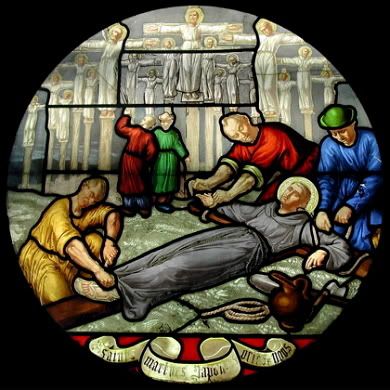
Today is the commemoration of the Martyrs of Japan. In 1549, Jesuits Francisco Xavier, Cosme de Torres, and John Fernandez arrived in Kagoshima from Spain with hopes of evangelizing Japan. Xavier visited Shimazu Takahisa, the daimyo of Kagoshima, asking for permission to build the first Catholic mission in Japan. The daimyo agreed in hopes of producing a trade relationship with Europe.
The shogunate and imperial government at first supported the Catholic mission and the missionaries, thinking that they would reduce the power of the Buddhist monks, and help trade with Spain and Portugal; however, the shogunate was also wary of colonialism, seeing that in the Philippines the Spanish had taken power after converting the population. The government increasingly saw Catholicism as a threat, and started persecuting Christians; eventually, the Catholic religion was banned and those who refused to abandon their faith were killed.
In 1597, twenty-six Christians (six European Franciscan missionaries, three Japanese Jesuits and seventeen Japanese laymen including three young boys) were executed by crucifixion in Nagasaki. The individuals were raised on crosses and then pierced through with spears. Persecution continued sporadically, breaking out again in 1613 and 1630, during which time Catholicism was officially outlawed. The church remained without clergy and was forced underground, but a remnant Christian community persevered until the arrival of Western missionaries in the nineteenth century.
While there were many more martyrs (numbering in the thousands), the first martyrs came to be especially revered, the most celebrated of which was Paul Miki. The Martyrs of Japan ("Paul Miki and his Companions") were canonized by the Vatican in 1862 and are commemorated on February 6.
Nippon Sei Ko Kai ("The Japanese Holy Catholic Church"), a member of the Anglican Communion, added the martyrs to their kalendar in 1959 in recognition of all the martyrs of Japan, commemorated on February 5. It was added to the kalendar of the Episcopal Church with the 1979 American revision of the Book of Common Prayer.

A monument dedicated to the Martyrs in Nagasaki.

The following, from the Office of Readings from the Liturgy of the Hours of the Latin Rite of the RCC, contains an account of the martyrdom (toward the bottom, the second reading):
ReplyDeletehttp://www.universalis.com/20070206/readings.htm
why do you keep spelling calander with a "k"?
ReplyDeletekause it's kool.
ReplyDeletesorry, sorry....couldn't help myself. It just slipped out.
"Kalendar" is a church thing, a liturgical calendar.
ReplyDelete